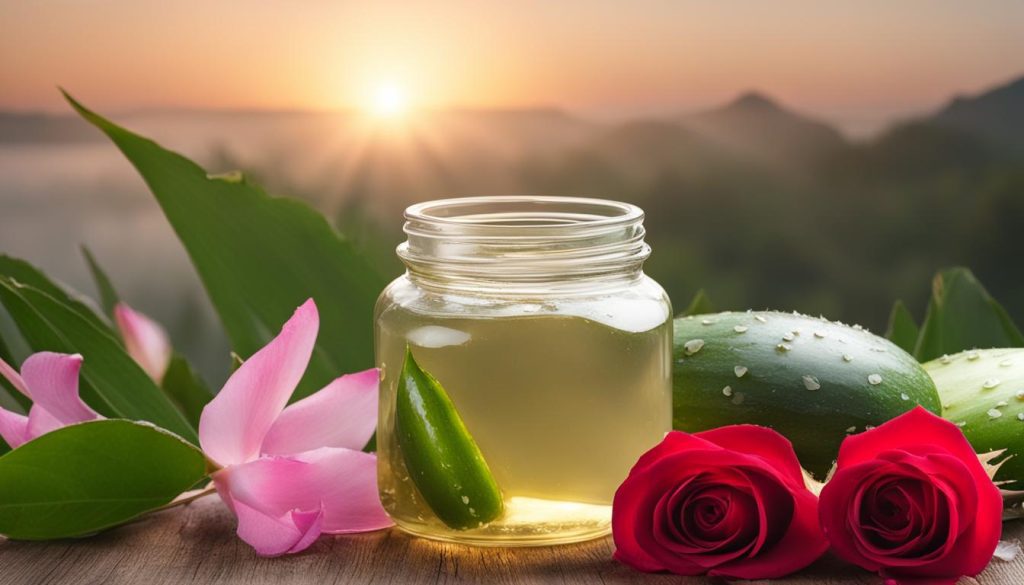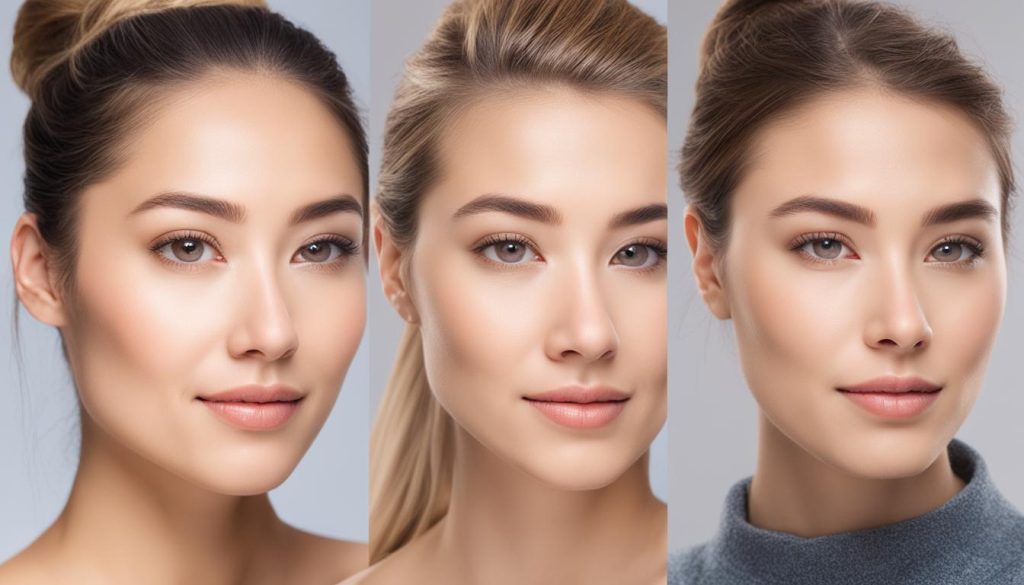Embarking on a journey to hydrate skin and achieve that elusive glow begins with the essentials — a robust face moisturizing routine. Throughout my career as a beauty enthusiast, I’ve tested a plethora of moisturizing facial products, all promising to quench the skin’s thirst. And let me tell you, the difference a tailored regimen can make is palpable. It’s not merely about choosing the best face moisturizer off the shelf; it’s about understanding how to properly moisturize your face to unlock skin’s full radiance.
As someone who’s navigated the vast terrains of skincare, I can attest to the difference when you moisturize your face with intention. You don’t just apply; you connect with your skin, answering its call for hydration with precision and care.
Moisturise Face
- Identifying and integrating the best face moisturizer is pivotal for peak skin hydration.
- A consistent face moisturizing routine serves as the bedrock of skin health and luster.
- Knowledge of how to moisturize the face effectively can elevate the results of your skincare regime.
- Choosing moisturizing facial products that align with your skin’s needs is crucial.
- Learning how to properly moisturize your face profoundly impacts skin texture and its ability to retain moisture.
- Hydrate skin with techniques and products that cater to individual skin types and concerns.
Understanding Facial Dehydration and Its Impacts
As someone who’s deeply invested in the art of skincare, I consider it essential to distinguish between a dry skin type and the temporary condition of dehydrated skin. The quest to moisturize face, improve facial hydration, and cater to dry skin regions requires this knowledge as a foundation. If you’ve grappled with the challenge to hydrate your face effectively, understanding these nuances can be the key to unlocking optimal face hydration strategies tailor-made for your skin’s unique needs.
The Difference Between Dry and Dehydrated Skin
While they may sound similar, dry skin and dehydrated skin are not the same. Dermatologists such as Corey L. Hartman, M.D., emphasize that dry skin is a skin type caused by a lack of oil, especially within the oil-producing glands. On the other hand, dehydration is a reversible condition caused by a lack of water in the skin. Identifying whether you need to moisturize dry skin or boost your overall facial hydration can determine the most effective skincare regime for your face.
Common Symptoms of Dehydrated Skin
How do you tell if your skin is dehydrated? The signs can be easily spotted, even without the keen eye of a dermatologist like Dendy Engelman, MD. Dehydrated skin often presents with roughness, flakiness, and a sense of tightness; it lacks the plumpness of well-hydrated skin. You may observe that no matter how much you try to moisturize your face, these symptoms persist until you address the fundamental issue – your skin’s need for water.
The Role of Diet in Skin Hydration
One aspect of face hydration that is sometimes overlooked is the role of diet. To effectively hydrate your face from the inside out, it’s important to include foods in your diet that are rich in essential omega-3 fatty acids, like avocados, nuts, seeds, and oily fish. These foods bolster the skin’s ability to retain moisture, contributing to a well-moisturized appearance. For an extra boost, products like Artah’s Essential Omegas can supplement your dietary intake, ensuring your skin receives the hydration it craves.
The Science Behind Moisturising Your Face
As I delve into the world of skincare, it’s evident that an effective moisturizing routine is key to maintaining a healthy complexion. The science of moisturizing is more intricate than one might assume; it is a delicate balance of ingredients that work in harmony to hydrate, nourish, and protect our skin. Let’s break down the components that make moisturizing creams an essential part of nurturing our skin’s natural beauty.
How Moisturizers Work to Nourish Skin
Moisturizing creams are not just about adding moisture to the skin, but about creating an environment for skin to hold onto that moisture. Hydrating face products combined with the skin’s natural oils form a barrier that prevents water loss and keeps the skin soft and pliable. Nourishing the skin involves fortifying this barrier to improve overall skin health.
Components of an Effective Moisturizing Cream
When selecting a moisturizing cream, one should look for products that contain a synergistic blend of humectants, emollients, and occlusives. Each type of ingredient has a specific role in maintaining the skin’s hydration levels and ensures that moisture is not only delivered but retained.
Understanding Humectants, Emollients, and Occlusives
Humectants are like magnets for moisture; they attract water from the atmosphere and the deeper layers of the skin to the outer layer. Emollients are smoothing agents that fill in the cracks and smooth the skin, making it feel soft and supple. Occlusives create a physical barrier to prevent moisture loss, acting as a seal over the skin to lock in all the beneficial ingredients and hydration.
- Humectants: Glycerin, hyaluronic acid
- Emollients: Ceramides, squalane
- Occlusives: Petrolatum, beeswax
By understanding the science and function behind these key elements, we can choose moisturizing skincare that effectively addresses our unique skin concerns, leaving it well-hydrated and better equipped to resist the signs of aging. Nourishing our skin is thus not a one-step process but a multi-faceted approach involving various types of products and ingredients.

Creating a Moisturizing Skincare Routine
As someone deeply passionate about skincare, I’ve realized that mastering how to moisturize the face is more than a simple task; it’s an art that involves listening to your skin’s needs and adapting as they change. Moisturizing is a critical step in my skincare routine, ensuring that my skin remains soft, supple, and radiant. It’s essential to note that an effective routine involves several steps to moisturize your face effectively. Let me guide you through the process that I’ve honed over years of experience and research.
Firstly, it’s crucial to begin with a clean slate. I trust in using a gentle cleanser to remove impurities without stripping the skin of its natural oils. After cleansing, while the skin is still slightly damp, I apply a hydrating toner to further prepare my skin for moisture absorption. This is when the magic happens: I apply my favorite face moisturizer, which contains a rich blend of emollients and humectants.
- Emollients, like shea butter and squalane, help to soften and smooth the skin.
- Humectants, such as hyaluronic acid, attract moisture from the deeper layers of the skin and the environment to hydrate the surface layers.
To maximize the benefits of a facial moisturizer, it’s advisable to apply it using upward strokes, encouraging better absorption and circulation. An essential final step in my regimen is to seal all these hydrating products with an occlusive agent, like a facial oil, which locks in the moisture and protects against water loss.
Diligence in this routine, morning and night, ensures that my skin is not only moisturized but also protected from environmental factors. Remember, consistency is key in any effective skincare routine. So, let’s commit to regular self-care and embrace the radiance we deserve.
Top Ingredients for Optimal Facial Hydration
As an ardent advocate for a healthy skincare regimen, I recognize the importance of using cornerstone ingredients in facial moisturizers that ensure your face retains that much-needed moisture. After thoroughly researching and integrating these elements into my daily routine, I’ve seen first-hand the pivotal role they play in enhancing face hydration. Allow me to guide you through some of the most advantageous components that can amplify the efficacy of moisturizing facial products and elevate your skin’s hydration levels.

Hyaluronic Acid: This naturally occurring polysaccharide has the remarkable ability to bind and retain water molecules, which is essential for maintaining a plump and hydrated complexion. Found in a myriad of hydrating face products, hyaluronic acid serves as a fundamental hydrating agent for those seeking dewy, refreshed skin.
Glycerin: Another humectant that I frequently tout for its water-attracting properties is glycerin. Its presence in skincare ensures that moisture is drawn into the epidermis, providing a hydration boost that can visibly soften and smooth the skin’s texture.
Ceramides and Squalene: Both ceramides and squalene are emollients that I highly endorse for their ability to reinforce the skin’s natural barrier. This fortification helps prevent moisture loss and shields the skin from environmental irritants, making them vital ingredients in moisturizing facial products.
Aloe, Vitamins A, E, and C: Aloe vera is renowned for its soothing and hydrating qualities, making it a go-to for inflamed or irritated skin. Vitamins A, E, and C, often incorporated into superior facial moisturizers, offer antioxidant benefits in addition to their moisturizing capabilities, protecting skin from free radical damage while boosting hydration.
Colloidal Oat: Lastly, colloidal oat is known for its ability to soothe itchy, dry skin, as well as offering moisturizing properties. This ingredient works to calm the skin while also providing a layer of protection that helps retain natural moisture.
Investing in products rich in these ingredients has greatly improved the resilience and hydration status of my skin. By prioritizing these key components within your skincare arsenal, you too can achieve an optimal level of face hydration, and thereby, a more radiant and youthful appearance.
Lifestyle Adjustments to Maximise Skin Health
As someone who values the radiance of well-nourished skin, I’m always seeking new ways to hydrate my face and moisturize dry skin. It’s become increasingly clear that a holistic approach is key. Meaningful changes to my daily routine have had a profound impact on my skin’s health, emphasizing that how to properly moisturize the face extends beyond topical treatments.
Importance of Water Intake for Hydrated Skin
My journey to nourish my skin begins with hydration from the inside. I make it a point to drink plenty of water throughout the day. Hydration is the cornerstone of skin health, and adequate water intake acts as the internal moisturizer that complements my skincare regimen, ensuring my face remains plump and hydrated.
Food Choices That Support Face Moisturization
- Avocados – packed with beneficial fats and vitamins
- Walnuts – a great source of omega-3 fatty acids
- Leafy Greens – high in antioxidants and water content
- Berries – rich in vitamins and anti-inflammatory properties
Integrating these hydrating foods into my diet has provided my skin with the nutrients it needs to thrive, allowing me to better moisturize my face from within.
Avoiding Dehydrating Habits and Environment
- Minimizing exposure to harsh winds and sun
- Using a humidifier during dry seasons
- Avoiding overindulgence in alcohol and caffeine
- Choosing lukewarm showers over hot ones
By steering clear of these drying factors, I’ve been able to preserve my skin’s moisture balance, contributing significantly to my face’s ability to retain hydration and look its best.
Hydrate & Glow: How to Properly Moisturise Face
Unlocking the secret to a dewy, radiant complexion starts with understanding how to properly moisturize the face. Every step taken towards maintaining a well-hydrated skin can contribute to a natural glow and improved skin health. In my routine, I focus on personalized skincare practices that align with my skin’s specific needs. Sharing these insights, I’ll guide you through a transformative moisturizing process that can cater to all skin types.
Step-by-Step Guide to Applying Facial Moisturizer
Initiating the routine, I begin with a gentle cleanser to ensure that my skin is free from impurities. Subsequently, a hydrating toner paves the way for optimal absorption of moisture. Here’s how I ensure to moisturize my face effectively:
- Apply a hydrating toner or essence to a cleansed face, dabbing it gently to enhance hydration.
- While the skin is still damp, I smoothly layer on a humectant-infused product.
- I follow this with a rich emollient cream to repair and strengthen the skin barrier.
- An occlusive oil is the final touch, locking in all the accrued moisture.
Choosing The Right Face Moisturizer for Your Skin Type
To zero in on the best face moisturizer for my skin, I consider my skin type — be it oily, dry, combination, or sensitive. Dry skin types benefit from cream-based moisturizers with a rich feel, whereas water-based, non-comedogenic moisturizers are ideal for oily or acne-prone skin. Sensitive skin types may opt for hypoallergenic and fragrance-free options to avoid irritation.
Maximizing Moisturization Through Layering Techniques
- To enhance the moisturizing effect overnight, I apply a hydration-boosting serum beneath my nighttime cream.
- Layering a hydrating sleep mask gives my skin an extra dose of hydration, ensuring I wake up with a supple texture.
Integrating these layering techniques does wonders for how I moisturize the face before bedtime, turning it into a sanctuary of overnight rejuvenation.
Innovative Hydrating Face Products on the Market
As someone deeply invested in my skincare, I am always on the lookout for products that promise to elevate my face moisturizing routine. The current beautyscape is brimming with hydrating face products designed to cater to our skin’s unique hydration needs. Whether it’s a serum infused with hyaluronic acid or a cream enriched with ceramides, the array of moisturizing skincare options is impressive and bountiful.
Among the standout innovations I’ve come across are facial moisturizers that combine time-released hydrators and a blend of vitamins to provide all-day moisture. The beauty of a comprehensive face moisturizer lies in its ability to not just replenish lost hydration but to lock it in, creating a reservoir of moisture that keeps the skin supple and glowing throughout the day and night.
- Cutting-edge serums with multi-molecular hyaluronic acid ensuring hydration at various skin depths
- Creams formulated with a fortifying mix of ceramides and essential lipids to reinforce the skin barrier
- Overnight masks leveraging a cocktail of antioxidants and essential fatty acids to rejuvenate and hydrate skin as you sleep
Such innovations are not only a testament to the advancement in skincare technology but also reflect the growing demand for more sophisticated moisturizing skincare regimes. Staying abreast of these developments is key to keeping my complexion hydrated, balanced, and radiant.
Conclusion
In this comprehensive guide, I’ve underscored the importance of differentiating between skin that is dry versus skin that is dehydrated. Understanding this distinction is the first step in addressing one of the most prevalent barriers to achieving a supple and luminous complexion. Facial dehydration impacts not just the surface appearance, but also the deeper vibrancy of our skin. My intention has been to equip you with the knowledge necessary to effectively moisturize your face, addressing concerns from simple dryness to complex hydration needs.
Summarizing the Key Takeaways for Facial Hydration
The pathways to ultimate facial hydration require not only recognizing the contrast between dryness and dehydration but also mobilizing a skincare routine that integrates potent moisturizing ingredients. I’ve explored the efficacy of various hydrating face products and emphasized the critical roles of humectants, emollients, and occlusives. Acknowledging the signs of dehydrated skin enables you to respond proactively with the most appropriate skincare regimen to moisturize dry skin.
Embracing a Holistic Approach to Moisturize Your Face
The zenith of skin health isn’t achieved by a solitary action but through a holistic approach that considers dietary choices and lifestyle habits. From integrating foods rich in omega fatty acids to fine-tuning your skincare routine to include layers of hydration, my narrative has been a reminder that an all-encompassing approach is essential. It’s truly about nurturing skin from within and protecting it externally. By heeding these lessons, you’re well on your way to maintaining consistent facial hydration and delighting in a visage that not only appears hydrated but truly embodies it.
FAQ
What’s the difference between dry and dehydrated skin?
Dry skin lacks oil because it has fewer oil-producing glands, making it feel flaky and rough. Dehydrated skin, on the other hand, lacks water, resulting in tightness and dullness. It’s possible to have oily skin that’s dehydrated, indicating the need for proper hydration.
What are the common signs of dehydrated skin?
Dehydrated skin often exhibits rough texture, flakiness, dull complexion, and the sensation of tightness. These signs indicate that your skin is in need of more effective moisturization to restore its water content.
How can diet affect skin hydration?
A diet rich in omega-3 fatty acids and antioxidants can improve the skin’s hydration. Foods like avocados, nuts, seeds, oily fish, and supplements such as omega-rich oils can foster a more hydrated complexion from within.
How do moisturizers work to nourish the skin?
Moisturizers nourish the skin by using a blend of humectants, emollients, and occlusives to draw, retain, and seal moisture in the skin. This combination of ingredients helps keep the skin hydrated, soft, and smooth.
What should an effective moisturizing cream contain?
An effective moisturizing cream should contain humectants such as glycerin and hyaluronic acid to draw water into the skin, emollients like ceramides and squalane to smooth and repair the skin barrier, and occlusives such as beeswax and shea butter to seal in hydration.
Why is it important to understand humectants, emollients, and occlusives?
Understanding these components is essential as they each play a different role in hydrating the skin. Humectants attract moisture, emollients smooth and repair, and occlusives lock in hydration. Knowing how they work can help you choose the right products for your skincare routine.
How much water should I intake for hydrated skin?
While individual needs vary, it’s generally recommended to drink at least 8 glasses (64 ounces) of water a day to maintain good skin hydration. Paying attention to your body’s cues and drinking more in hot weather or after exercise is also important.
What foods support face moisturization?
Foods that are high in water content, such as cucumbers, tomatoes, oranges, and watermelon, help support facial moisturization. Additionally, foods rich in healthy fats like nuts, seeds, and fatty fish contribute to a more hydrated and plump complexion.
How can I avoid dehydrating my skin?
To avoid dehydrating the skin, limit exposure to harsh cleansing agents, reduce the intake of alcohol and caffeine, avoid long, hot showers, and protect your skin from extreme weather conditions. Using a humidifier, especially in dry climates or during winter months, can also help.
What’s the best way to apply facial moisturizer?
Apply your facial moisturizer to slightly damp skin after cleansing to boost absorption of active ingredients. Start with a thinner consistency product such as a serum, followed by a thicker cream, and finish with an oil or occlusive to seal in the moisture if needed, especially at night.
How do I choose the right face moisturizer for my skin type?
Identify your skin type (dry, oily, combination, sensitive, normal) and choose a moisturizer formulated for that type. Look for non-comedogenic products if you have acne-prone skin, richer creams for dry skin, and lighter, hydrating formulas for oily skin.
What are layering techniques for maximizing moisturization?
Layering techniques involve applying skincare products from thinnest to thickest consistency to maximize moisturization. After cleansing and toning, apply a hydrating serum followed by a moisturizer and seal with a face oil or sleep mask for enhanced hydration.
What innovative hydrating face products are available on the market?
The market offers a variety of hydrating face products, including serums with high concentrations of hyaluronic acid, ceramide-infused moisturizers for barrier repair, and overnight masks packed with antioxidants and essential fatty acids to deeply moisturize while you sleep.






